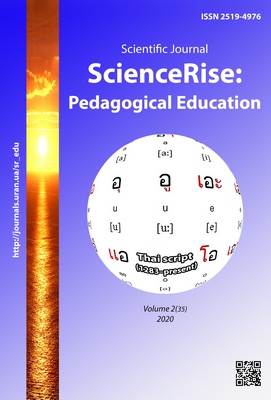Research method of the synonymy phenomenon of family lexemes on the basis of the communicative and activity approach
DOI:
https://doi.org/10.15587/2519-4984.2020.199298Keywords:
communicative and lexical competence, communicative-activity approach, family vocabulary, related nominations, synonymyAbstract
The article is about the theoretical analysis of methodological, pedagogical, psychological, professional and other literature on the problem of the study of the phenomenon of synonymy of related lexemes and methods of teaching them on the basis of communicative-activity approach. There was determined the initial level of ownership of such concepts as «family vocabulary» and «synonymy of related lexemes», practical skills of constructing own utterances, the ability to use synonyms-correspondences in a creative context were clarified. A system of exercises has been developed that aims at developing empathy in the classroom, friendliness and ability to understand one another more deeply, to be able to pick up synonyms for these units, and explain their lexical meaning. There was introduced and realized a number of psychological and rehabilitation exercises in the class family, the skills of forgiving and asking for forgiveness.
Among the conditions that ensured the effectiveness of the communicative activity approach there was the creation of a favorable psychological microclimate of the team, comfort and acceptance of each of its members individually. It was shown the importance to support humanity and tolerance towards the participants of the educational process and for each individual personally. The system of intersubject links is implemented in the context of a certain algorithm of actions, namely: before, directly, and after the exercise. The self-reflection stage is closely linked to the language material in the lesson. There were discussed semantic shades of synonyms of family vocabulary and variants of their use in certain situations of associative experiments. The creative use of IT in the context of the study synonymy of family vocabulary, based on the communicative-activity approach, is proposed
References
- Wierzbicka, A. (1997). Understanding Cultures Through Their Key Words: English, Russian, Polish, German, Japanese. New York: Oxford University Press, 317.
- Bohn, R. (2000). Probleme der Wotschatzarbeit. München: Langenscheidt, 192.
- Schneider, W. (2008). Speak German!: Warum Deutsch manchmal besser ist. Hamburg: Rowohlt, 192.
- Matsko, L. I., Hruba, T. L., Semenoh, O. M., Symonenko, T. V. (2017). Ukrainska mova 10-11 klasy. Prohrama dlia profilnoho navchannia uchniv zahalnoosvitnikh navchalnykh zakladiv. Filolohichnyi napriam, profil – ukrainska filolohiia. Kyiv: Proekt. Ministerstvo nauky i osvity Ukrainy, 94.
- Horoshkina, O. M. (2013). Rol rytoryky v komunikatyvnii pidhotovtsi uchniv. Naukovi zapysky Natsionalnoho universytetu «Ostrozka akademiia». Seriia: Filolohichna, 40, 137–140.
- Neshcheret, O. I. (2016). Psykholohiia movlennievoi diialnosti: osnovy psykholohinhvistychnykh znan. Nizhyn: NDU im. M. Hoholia, 200.
- Varzatska, L. (2011). Dydaktychni tsili, typy, struktura urokiv ukrainskoi movy i movlennia. Dyvoslovo, 6, 9–14.
- Pentyliuk, M. I. (2010). Vykhovnyi potentsial simi: tradytsii, realii ta perspektyvy. Ridna shkola, 12, 74–75.
- Pentyliuk, M. I. (2015). Culture of professional communication of future professionals. Naukovyi visnyk Mykolaivskoho yftsionalnoho universytetu imeni V. O. Sykhomlynskoho. Seria: Pedahohichni nauky, 14, 144–151.
- Zatvorniuk, O. M. (2018). Psykholohiia simi. Kyiv: Vydavnychyi Dim «Slovo», 184.
- Matsiuk, Z., Stankevych, N. (2011). Ukrainska mova profesiinoho spilkuvannia. Kyiv: Karavela, 352.
- Manakin, V. M. (2012). Mova i mizhkulturna komunikatsiia. Kyiv: Akademiia, 288.
- Kaplinskyi, V. V. (2017). Metodyka vykladannia u vyshchii shkoli. Kyiv: KNT, 225.
- Ponomariv, O. D. (2012). Ukrainske slovo dlia vsikh i kozhnoho. Kyiv: Lybid, 360.
- Holub, N., Protsenko, L. (2016). Metodyka navchannia leksykolohii ta frazeolohii v shkilnomu kursi ukrainskoi movy. Nizhyn: NDU im. M. Hoholia, 223.
Downloads
Published
How to Cite
Issue
Section
License
Copyright (c) 2020 Tetiana Rudiuk

This work is licensed under a Creative Commons Attribution 4.0 International License.
Our journal abides by the Creative Commons CC BY copyright rights and permissions for open access journals.
Authors, who are published in this journal, agree to the following conditions:
1. The authors reserve the right to authorship of the work and pass the first publication right of this work to the journal under the terms of a Creative Commons CC BY, which allows others to freely distribute the published research with the obligatory reference to the authors of the original work and the first publication of the work in this journal.
2. The authors have the right to conclude separate supplement agreements that relate to non-exclusive work distribution in the form in which it has been published by the journal (for example, to upload the work to the online storage of the journal or publish it as part of a monograph), provided that the reference to the first publication of the work in this journal is included.








